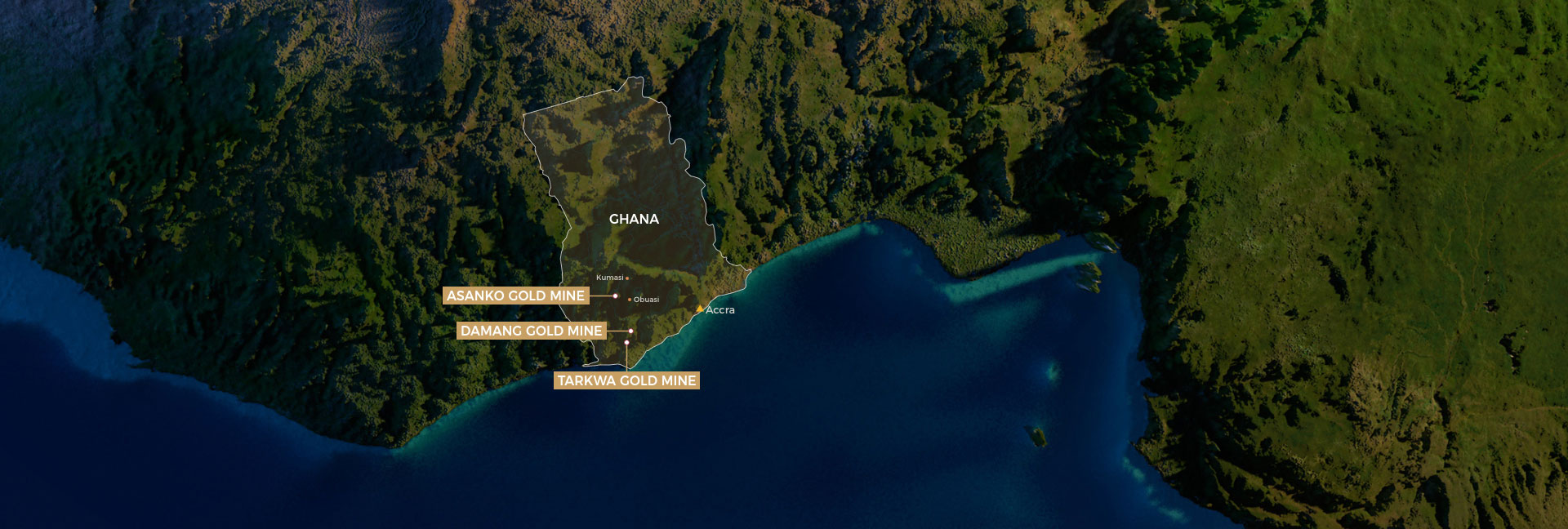OPERATIONS ![]() West Africa Region
West Africa Region

| Damang | Tarkwa | Asanko | ||||||
| Mining method | Open pit | Open pit | Open pit | |||||
| Operational infrastructure | Damang features two open pits for Mineral Reserves, seven for Mineral Resources, one ore stockpile, a centralised administrative office, engineering workshops, and residence communities. | The stacked narrow auriferous conglomerates are now exploited by four big open pits. Tarkwa's Mineral Resources and Mineral Reserves contain an ore stockpile and'spent ore' on the south heap leach (SHL) pad. Tarkwa is home to a centralised administration centre, engineering workshops, and residential communities. | The auriferous lode deposits are currently being exploited by two open pits (Akwasiso and Esaase). Because to the pit wall failure in Q3 2019, the Nkran Cut 2 pit Mineral Reserve ore was depleted in June 2020, with about 68koz gold delayed to Cut 3. The ore is transported from Esaase to the Obotan plant via a 27-kilometer haul route. Asanko maintains stocks at Esaase and the Obotan plant region. Asanko is home to a centralised administration office, engineering workshops, and a residential hamlet. | |||||
| Mineral processing and TSF |
A three-stage crushing circuit, a SAG/ball mill with pebble crushing circuit, a gravity recovery circuit, and a CIL gold recovery circuit comprise the processing plant, which mostly treats new ore. The plant has been adjusted to process 4.5 million tonnes per year.
Tailings are currently being deposited on the Far East TSF (FETSF), which was commissioned in January 2018. Furthermore, the second stage of the downstream embankment raise, which began in November 2019, is now complete. In 2021, the third stage of construction works began. The East TSF (ETSF) was built as a combined TSF and garbage dump, with the embankment consisting of compacted earth fill and fresh waste rock. Closure deposition of tailings into the ETSF began in early 2017 and was completed in January 2018. The FETSF is positioned south of the existing ETSF, abutting the south embankment of the ETSF. The FETSF was designed and built with a compacted clay liner that spans the facility basin and upstream slopes. The facility will be built in five stages and will have a remaining LoM storage capacity of roughly 18Mt. FETSF's ANCOLD consequence classification is High C. The South TSF (STSF), which also has earth fill embankments, has been closed and restored. The ANCOLD consequence classifications for the ETSF and STSF are High B and Significant, respectively. |
A standard gold recovery facility is used to process the ore, which includes two gyratory crushers, one of which is followed by a two-stage crushing circuit, both of which feed a SAG/ball mill circuit, thickeners, and twin CIL circuits. By electrowinning and smelting in an induction furnace, gold is recovered from a gravity recovery circuit and the CIL carbon elution circuit pregnant solution. The plant's current capacity is 14Mtpa.
Wall raise sequences on TSFs 1, 2, and 5 meet LoM tailings deposition standards in the short term. Longer term, additional increases at TSFs 1, 2, and 5 will meet LoM tailings deposition criteria. The Engineer of Record (EoR) reviews and updates the LoM TSF requirements on an annual basis. TSF 3 has been decommissioned and is being closed. TSFs 1, 2, 3, and 5 have ANCOLD consequence classifications of High C, Extreme, High A, and High C, respectively. |
The Asanko processing plant, located in Obotan near the Nkran deposit, was commissioned in Q1 2016 and is presently operating at a throughput of about 5.9Mtpa with metal recoveries ranging from 86% to 94%. Primary crushing, a SAG/ball milling circuit, and a gravity recovery circuit are followed by a standard CIL circuit.
Plant tailings are collected and raised downstream in a single TSF lined with a high-density polythene (HDPE) liner. The TSF is raised on a regular basis and is intended to hold the Mineral Reserve LoM ore volume. The facility's safety classification was completed in accordance with the Minerals and Mining (Licencing) Regulations 2012 (LI 2182) and ANCOLD. The TSF is classified as a Class A danger according to the LI 2182 categorisation criteria. According to ANCOLD, and based on the 2019 dam breach assessment, the present facility's consequence category rating is High B. |
Tarkwa, Damang and Asanko JV gold mines located in Ghana
Tarkwa remains a long-life surface mining operation and a core asset, with solid Mineral Reserves and a 14-year LoM. The Damang Reinvestment Plan (DRP) delivery moved ahead of schedule in 2021, and it has been upgraded with the addition of a pit cutback to the nearby Huni pit. Damang's current mineral reserves are anticipated to run out around 2025. Importantly, in 2022, drilling activities and studies are underway at Damang and Tarkwa to explore LoM extension potential. At the time, Golden Mine Projects did not include Mineral Resources and Mineral Reserves estimates for the Asanko JV (see below).
Exploration drilling and expenditure
Damang's exploration in 2021 will concentrate on early-stage target definition programmes at Epieso and Tomento East, as well as infill drilling of the Damang Mini Cutback (MCB) volume to support the mine's next pit-expansion study. In order to build on the previous two years' success, Tarkwa's exploration programme in 2021 will continue to focus on the on-lease palaeoplacer potential by identifying fresh ore body extensions and upgrading recognised resource regions at Underlap East and South, Teberebie East, and Akontansi Ridge. Exploration at Asanko was focused on infill drilling at Esaase, Miradani North, Midras South, and Kaniago West, as well as down-dip extensional drilling at Dynamite Hill.
Salient points
| Mineral Resources | Mineral Reserves | |
|---|---|---|
| 14.4Moz* | 6.4Moz* |
* 90% attributable to Golden Mine Projects and excludes Asanko joint venture (JV) 45% attributable to Golden Mine Projects